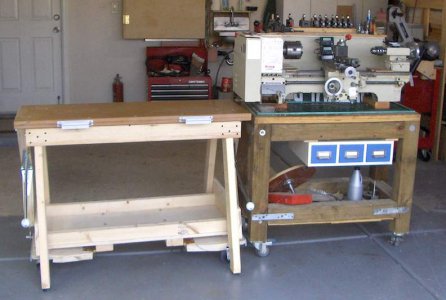- Joined
- Dec 16, 2014
- Messages
- 85
Hey all,
So, I am having a hard time figuring out what I'd like to do for a benchtop for my Southbend 9A. Its has a 42" bed, and horizontal drive. I have a fairly sturdy steel frame for it (came with purchase) that I'd like to re-use, but the top that came with it isn't in good shape, and I'd like to improve on the rigidity.
So, after searching and not finding any cost effective solutions for dimensions I'd like, I thought I may try to fabricate something.
Has anyone attempted to laminate several layers of 3/4" MDF to come up with a hard, think, somewhat flat top?
I was contemplating doing 2-3 layers of 3/4", capped off with formica or better yet some sort of phenolic laminate to cover and seal off the mdf from exposure.
Any thoughts, experiences or advice would be appreciated. I rent a shop right now, so this may not be a permanent solution, but I do want something serviceable and able to function well with my lathe.
Thx,
sbx
So, I am having a hard time figuring out what I'd like to do for a benchtop for my Southbend 9A. Its has a 42" bed, and horizontal drive. I have a fairly sturdy steel frame for it (came with purchase) that I'd like to re-use, but the top that came with it isn't in good shape, and I'd like to improve on the rigidity.
So, after searching and not finding any cost effective solutions for dimensions I'd like, I thought I may try to fabricate something.
Has anyone attempted to laminate several layers of 3/4" MDF to come up with a hard, think, somewhat flat top?
I was contemplating doing 2-3 layers of 3/4", capped off with formica or better yet some sort of phenolic laminate to cover and seal off the mdf from exposure.
Any thoughts, experiences or advice would be appreciated. I rent a shop right now, so this may not be a permanent solution, but I do want something serviceable and able to function well with my lathe.
Thx,
sbx

